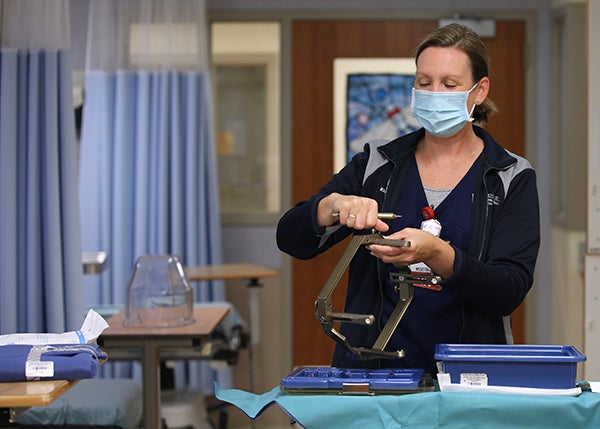Gamma Knife radiosurgery is a proven alternative to open brain surgery. As accurate as a surgeon’s scalpel, it uses focused beams of radiation to target the treatment area.
Skilled in Gamma Knife radiosurgery since 2006, Penn State Health neurosurgeons, radiation oncologists and other neurosurgery team members have performed more than 3,000 Gamma Knife procedures. The new Gamma Knife Icon is the latest generation of the device. It uses MRI and other advanced imaging techniques to precisely target locations within the brain. This ensures that any surrounding tissues receive minimal exposure and minimizes side effects.
Penn State Health Gamma Knife Radiosurgery:
What it is and what to expect
What are the benefits of Gamma Knife radiosurgery?
Since no incision is made, the risk of surgical complications is low. The patient's head does not have to be shaved, and side effects are few. Gamma Knife offers both frame-based and frameless immobilization. For patients who can be treated in a single session, the frame-based system is used for more accurate localization, easy stabilization and planning. When the fixed frame stabilization is not an appropriate choice, patients can be treated using a mask-based immobilization system that is personalized for every patient. Patients who have complex tumors arising from the sinuses or orbits, multiple tumors in different locations or tumors larger in size may require more than one treatment using the mask-based system.
More precise treatment means faster recovery. A treatment can be completed in one to five sessions and seldom takes more than an hour or two. Gamma Knife patients are able to go home the day of the procedure and return to their normal daily routines the next day, compared to traditional brain surgery where an inpatient hospital stay is required and recovery often takes several weeks. The full effects of Gamma Knife surgery may not be seen for several months following treatment.
What diseases can be treated with Gamma Knife?
- Benign or malignant brain tumors
- Trigeminal neuralgia
- Arteriovenous vascular malformations (AVM)
- Cavernous malformations
- Acoustic neuromas (schwannoma)
- Parkinson's disease and essential tremor
- Lesions causing epilepsy
Gamma Knife treats many types of tumors, including metastatic cancers from lung, breast, ovary or skin. Certain metastatic cancers, like renal cell or melanoma, do not typically respond well to traditional fractionated radiation. Gamma Knife offers these patients the option for a single high-dose treatment to stop the spread of cancer in their brain. Icon can treat many more tumors than previously possible, saving the patient from receiving whole brain radiation, which is known to have significant long-term effects on memory and cognition and is often used as a last resort. People who have already had whole brain radiation sometimes get regrowth or new brain tumors six months or a year later and cannot safely have more whole brain radiation. Often, these people can still have a focused Gamma Knife treatment that puts a high radiation dose into the tumor, but only a very small amount into the surrounding brain, giving them a new chance for longer survival.
A proven alternative to invasive brain surgery
Gamma Knife is very effective in stopping further growth and even shrinking slow-growing tumors deep in the head called meningioma, pituitary adenoma, and vestibular schwannoma (also known as acoustic neuroma). People who had open surgeries for these slow-growing tumors sometimes find several years later the tumor is coming back and getting bigger. Tumors that are growing back are often straightforward to treat with Gamma Knife, without having to go through another open skull operation.
 Gamma Knife treats more than cancer. A special type of face pain characterized by electric stabbing pain — called trigeminal neuralgia — is sometimes resistant to medications, or the medications cause serious side effects. Gamma Knife treatments can give relief to many people, with up to half completely pain-free, and only a small risk of numbness.
Gamma Knife treats more than cancer. A special type of face pain characterized by electric stabbing pain — called trigeminal neuralgia — is sometimes resistant to medications, or the medications cause serious side effects. Gamma Knife treatments can give relief to many people, with up to half completely pain-free, and only a small risk of numbness.
Usually hand tremor from Parkinson's disease or essential tremor can be treated with medications or deep brain stimulation with implanted electrodes. In certain patients, Gamma Knife can be used to make a permanent lesion in part of the brain to help control the tremor in one hand.
Certain blood vessel abnormalities inside the skull and brain can be treated with Gamma Knife. Sometimes these require multiple treatments, including open neurosurgery and intravascular injections of coils and glue. Arteriovenous malformation (also called AVM) and dural arteriovenous fistula (or DAVF) are two conditions that have been successfully treated with radiosurgery, sometimes with no other treatment, and sometimes as part of multiple approaches.
The above conditions, from tumors, trigeminal neuralgia and tremor to vascular malformations, are all standard and accepted indications for Gamma Knife and are covered procedures paid for by government and private insurance like any other open neurosurgical operation.
